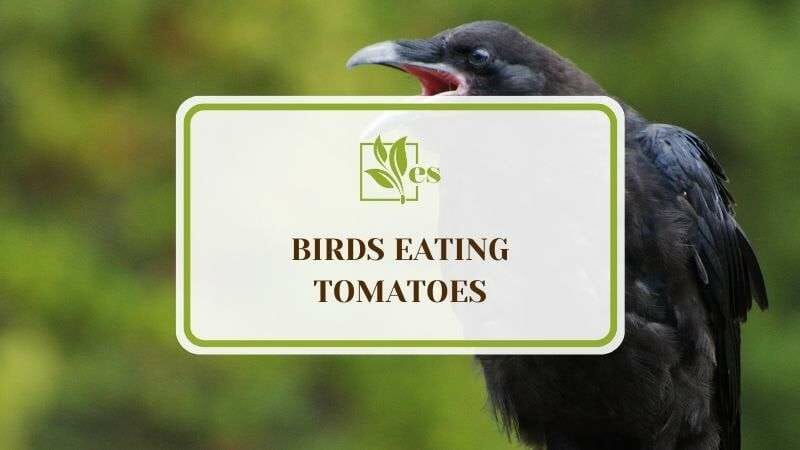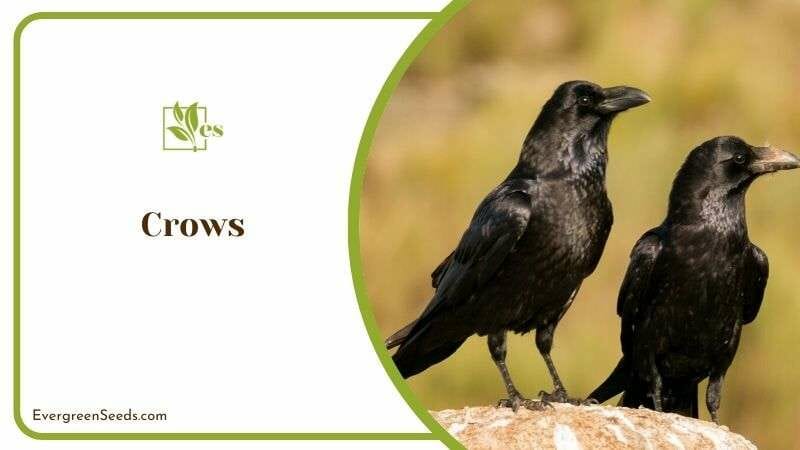Birds eating tomatoes can be frustrating for people. But to keep pet birds, you want to know all about them. Keep your tomato plants safe from winged invaders with our detailed article.

We’ll introduce you to the most common birds that may be attracted to your tomatoes, such as crows, blue jays, pigeons, and more, and their feeding habits. These animals, thankfully do not pray on cabbages, on mints, or basils.
JUMP TO TOPIC
A List of Birds Eating Tomatoes
1. Crows

Crows have diverse diets, indulging in various fruits, vegetables, and scavenging activities. While they might consume garden produce such as tomatoes, encouraging diverse habitats can deter them.
Crows inhabit a range of environments such as forests, grasslands, deserts, and urban areas. Understanding their habitats helps gardeners implement strategic measures to safeguard their produce.
Crows boast strong, large beaks, allowing them to explore various foods, including fruits and vegetables. Gardeners should consider these features while employing deterrent methods, ensuring the safety of their crops.
Crows can wreak havoc in gardens, damaging eggplants and devouring tomatoes. Gardeners need to employ effective deterrents to protect their crops and ensure a bountiful harvest.
Crows are a common bird species found throughout North America and are known for their intelligence and adaptability. They are known for their interest in shiny objects. They have been observed to eat a varied diet that includes a variety of fruits and vegetables. Tomatoes are one food item that crows have been observed eating.
Crows have been seen consuming tomatoes in both natural and cultivated gardens. They’ve pecked at ripe tomatoes and yanked unripe green tomatoes right from the vine. Crows can quickly decimate a tomato crop, which can be frustrating for gardeners trying to grow tomatoes.
It is important to remember and see more that crows are wild animals simply looking for food to survive.
Crows are opportunistic feeders, meaning they eat whatever food they can get, including a juicy tomato plant. They are opportunistic but also very intelligent and adapt well to new food sources and changing environments. This is why crows are such a fascinating species to study and observe.
There are many possible methods to protect tomato plants from birds. One is to use physical barriers such as bird netting or chicken wire to cover plants.
2. Sparrow

Sparrows have a diverse diet, feasting on various seeds, fruits, and vegetables. While their foraging habits can aid in insect control, gardeners must protect their crops to ensure a thriving harvest.
Sparrows thrive in diverse habitats, from forests and grasslands to urban areas. While they add charm to gardens, their presence may require protective measures to safeguard crops.
Sparrows sport small, conical beaks, ideal for seed consumption. In gardens, their beaks enable them to feed on various seeds, sometimes posing a challenge for gardeners. Employ netting or bird feeders to mitigate potential issues.
Sparrows, known for their fondness for seeds and fruits, can cause damage in gardens, especially on crops. To protect your harvest, consider using mesh covers. These small measures can make a big difference
You might be thinking, “do birds eat tomatoes?” Let us tell you: sparrows are a common bird species found worldwide, and birds eat tomatoes. They are known for their small size and plain brown plumage.
They are omnivorous and opportunistic feeders, which means they will eat a wide variety of foods depending on what is available to them.
While they primarily feed on seeds, fruits, and insects, they will also eat other food items if they are readily available. This includes vegetables such as tomatoes. Sparrows may eat tomatoes in a backyard or garden setting if they are ripe and easily accessible in a row cover.
They will typically feed on the soft fleshy parts of the tomato and leave the skin and seeds behind. They can also eat tomato seedlings. So you must protect tomatoes from bird damage and keep that in perspective. If you are wondering whether birds devour tomatoes or magpies eat tomatoes, this is the answer: they love it.
It’s worth noting that tomatoes are not a primary food source for sparrows, and they may not actively seek out tomatoes to eat. Sparrows will prioritize their primary food sources, such as seeds and insects, over tomatoes. So, a good idea might be to use bushes or plants that attract insects or flies to divert the sparrows’ attention!
However, if tomatoes are readily available and easily accessible, sparrows will certainly take advantage of the opportunity to feed on them.
In addition, sparrows also consume insects, spiders, worms, and other invertebrates as a major part of their diet. Their diet may change with the seasons, depending on the food availability. Sparrows are adaptable and opportunistic feeders that can survive in various environments.
Since they are so small, an easy way to keep sparrows away is to use scare tactics such as hanging objects, including shiny and colorful objects, to prevent them from accessing a specific area.
3. Blue Jays

Besides tomatoes, blue jays also enjoy a diverse diet including nuts, seeds, fruits, and vegetables. While their foraging habits can be charming, gardeners must protect delicate plants using netting or decoys.
Blue jays thrive in diverse habitats like wooded areas, deciduous and mixed forests, even suburban gardens. While their vibrant presence enhances natural spaces, gardeners might need to protect crops.
Blue jays boast quite large, strong beaks, adapted for various tasks including cracking nuts and seeds. In gardens, their beak strength can impact the damage they do, influencing plant propagation and the overall ecosystem.
Blue jays, known for their vibrant plumage, can pose a challenge in gardens. Their penchant for eating crops and dominating bird feeders affects local flora and fauna, demanding creative solutions from gardeners.
Blue Jays are a common bird species found throughout North America, known for their distinctive blue and white plumage and their intelligence. They have a diverse diet, including nuts, seeds, fruits, and vegetables. One food item that Blue Jays have been observed eating is tomatoes.
Blue Jays have been known to peck at ripe tomatoes and pull off unripe green tomatoes. This behavior can frustrate gardeners trying to grow tomatoes, as Blue Jays can quickly decimate a tomato crop. Birds eating tomato plants’ leaves can be held back through a mesh around the crop.
However, it is important to remember that Blue Jays are wild animals looking for food to survive.
Blue Jays are known to be opportunistic feeders, which means they will eat whatever food is available to them. However, they also store food for later consumption, such as acorns and peanuts. They are intelligent and can adapt to new food sources and changing environments.
Now you are really wondering how to keep birds from eating tomatoes! Another way to keep away pest birds is the use fake predators like plastic snakes, owls or even something as simple as a balloon. It works on the same principle that scarecrows do!
4. Thrushes

Thrushes have been known to occasionally feast on ripe tomatoes and other garden crops. While they primarily consume insects, fruits, and snails, their foraging habits might lead them to garden delicacies, making it essential for gardeners to implement protective measures.
Thrushes thrive in diverse habitats including forests, woodlands, scrublands, grasslands, and gardens. Their presence in gardens promotes biodiversity, aiding in natural pest control, and adds to the overall ecological balance.
Thrushes possess short, slightly curved beaks, adapted for varied diets including insects and fruits. Their beak structure enables them to delicately feed on garden insects, aiding natural pest control.
Thrushes, though charming, can pose challenges in gardens by consuming crops and monopolizing bird feeders. Gardeners may need to employ protective measures to preserve their harvests.
There are eight types of thrushes found in North America, including native and migrant species. This does not include bluebirds, robins, fieldfare, Veery, and Solitaire, all members of the thrush family. Thrushes prefer dense, moist forest areas where their sweet melodies can be heard, but the bird is rarely seen.
Thrushes are long-distance flyers that migrate from North America to South America during the winter. The Hermit Thrush and Swainson’s Thrush have a wide range, while the Bicknell’s Thrush prefers the higher altitudes of the eastern mountains of Canada’s Maritime provinces and the northeastern states of the US. The Wood Thrush is found in the eastern United States and southeastern Canada.
Then there are the two northernmost species, the Gray-cheeked Thrush, which can be found throughout northern Canada, and the Varied Thrush, which can be found from Alaska to the southern Rockies.
The Aztec Thrush and Red-legged Thrush are vagrants that live in Mexico, Central America, and the Caribbean islands. These birds have even been seen eating ketchup, so for those wondering, can birds eat tomato sauce? The answer is yes.
5. Blackbird

Blackbirds primarily consume insects, seeds, and fruits, making them valuable for pest control. However, they might also feast on tomatoes and garden crops, so protective strategies are necessary.
Blackbirds thrive in diverse habitats like urban, suburban, and rural areas. While their presence can be beneficial for gardens due to insect control, protective measures are necessary to balance their impact on crops.
Blackbirds typically possess small beaks with a slight curve. While this beak shape is versatile for foraging on insects and fruits, it also enables them to consume garden crops like tomatoes when not managed properly.
Blackbirds, with their tendency to eat crops and hog bird feeders, pose challenges in gardens. Their inclination to peck at ripe tomatoes can lead to losses, making it essential for gardeners to employ protective measures.
Blackbirds are a common bird species found worldwide and are distinguished by their glossy black plumage. They consume a wide range of insects, fruits, and vegetables. Tomatoes are one food item that blackbirds have been observed eating.
Blackbirds frequently target ripe tomatoes, pecking at the softer parts of the fruit, such as the flesh and juice. This can be frustrating for gardeners trying to grow tomatoes because the birds can damage the fruit.
However, it is important to remember that blackbirds are wild animals simply looking for food to survive. Though inconvenient, it is a necessary part of the ecosystem.
6. Gulls

Gulls have diverse diets including fish, crustaceans, mollusks, worms, insects, eggs, small mammals, and even garbage. While they aren't primarily garden crop consumers, they might opportunistically peck at ripe or overripe fruits like tomatoes.
Gulls predominantly inhabit areas near coasts and large bodies of water. While not directly impacting gardens, coastal gardeners should be cautious as these birds might occasionally peck at ripe fruits like tomatoes.
Gulls possess relatively large, thick, and strong beaks, adapted for their varied diet. Gardeners near coastal areas should safeguard ripe fruits, like tomatoes, as gulls might occasionally peck at them and destroy crops.
Gulls can be troublesome garden visitors, causing annoyance as they hog bird feeders and occasionally peck at ripe tomatoes. Vigilance and protective measures are essential to preserve your harvest.
In general, gulls are large, long-winged birds with stout, hooked bills and fully webbed feet except for the hind toes. Unlike terns, which live in similar environments, gulls have larger wings and squared-off or rounded tails.
Many gull species have different colorations due to seasonal changes or maturity levels, making it difficult to identify the species of a given gull. Bill and leg coloration are excellent in identifying the characteristics of gulls.
Gulls primarily prey on fish, insects, mollusks, crustaceans, worms, mice, young birds, bird eggs, seaweed, and berries. Incubation The eggs of kelp gulls hatch after about 27 days, and the chicks leave the nest soon after.
Mortality rates can be high, as other gulls cannibalize eggs and chicks, resulting in up to 50 percent mortality rates in some colonies. Gulls typically nest in colonies, laying two to three eggs in shallow nests made of stones, seaweed, moss, and feathers. They can fly about 5 to 6 weeks after hatching and are self-sufficient about 7 to 8 weeks later.
7. Pigeons

Pigeons have a varied diet, consuming seeds, fruits, vegetables, and small invertebrates like insects and worms. They often peck at tomatoes and other garden crops, posing a challenge for gardeners.
Pigeons inhabit diverse environments, including cliffs, mountainous regions, and urban areas. In gardens, their presence can lead to challenges like crop damage, emphasizing the need for protective strategies.
Pigeons have relatively small, short, and thick beaks, which allow them to peck at various seeds and fruits. In gardens, their foraging habits can pose challenges, necessitating protective measures to safeguard crops.
Pigeons, although seemingly harmless, can be quite bothersome in gardens. They tend to hog bird feeders and are notorious for pecking at ripe tomatoes. Managing their presence is essential to safeguard your crops.
Pigeons, also known as Rock Pigeons, are a common bird species worldwide, particularly in urban areas. They eat a variety of seeds, fruits, and vegetables. Pigeons have been observed consuming tomatoes.
Pigeons have been observed pecking at ripe tomatoes and tearing off unripe green tomatoes. Pigeons can damage tomatoes, which can be frustrating for gardeners. However, it is important to remember that pigeons are wild animals simply looking for food to survive. While it may be inconvenient, it is ultimately a natural part of the ecosystem.
Pigeons are known to be opportunistic feeders, taking advantage of whatever food sources are available to them. They are specially adapted to urban environments and have been observed foraging for food in parks, gardens, and balconies. Dalen gardener trellis netting can keep unwanted visitors away.
They are also known to consume human waste and to adapt to new food sources and changing environments. Pigeons have been observed consuming tomatoes in general, but it is important to remember that they are wild animals whose behavior is a natural part of the ecosystem.
If you are wondering do birds eat cherry tomatoes or do birds eat tomato flowers, the answer is yes.
8. Magpies

Magpies have a varied diet that includes fruits and vegetables, making them potential garden intruders. They may eat tomatoes and other crops, posing a challenge for gardeners aiming to protect their harvest.
Magpies inhabit a variety of environments, including forests, grasslands, and urban areas. Their adaptability can pose challenges for gardeners, especially in urban gardens where they may disturb crops.
Magpies have long, pointed beaks, adapted for a varied diet that includes fruits and vegetables. Their sharp beaks enable them to explore gardens, sometimes causing challenges for gardeners.
Magpies, with their cleverness, can be a challenge in gardens as they hog bird feeders and are known to peck at ripe tomatoes. Gardeners need to employ creative strategies to protect their crops from these resourceful birds.
Do Magpies eat tomatoes? Magpies are a common bird species known for their intelligence and adaptability. They are also known to have a varied diet, including fruits and vegetables such as tomatoes. Although magpies are omnivorous, eating both animal and plant matter, they prefer animal protein, but they are opportunistic feeders and can eat whatever is available to them.
They can be attracted to gardens and fruit trees in urban areas and consume tomatoes and other fruits and vegetables. However, it is important to note that tomatoes should not make up a significant portion of a magpie’s diet, as they require a balanced diet of insects, worms, and other animal protein for optimal health.
And finally, another way of stopping birds it to simply not plant it where birds are likely to congregate.
Final note:
We hope you have enjoyed this read and gained valuable insights into the behavior of birds that can feast on tomatoes and can now take the appropriate action. You should also be aware that possums love tomatoes, so you need to protect them.












